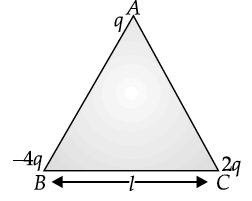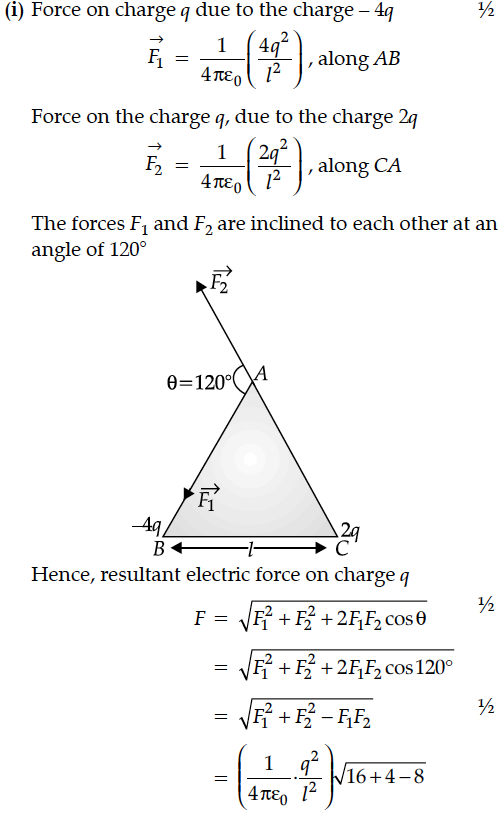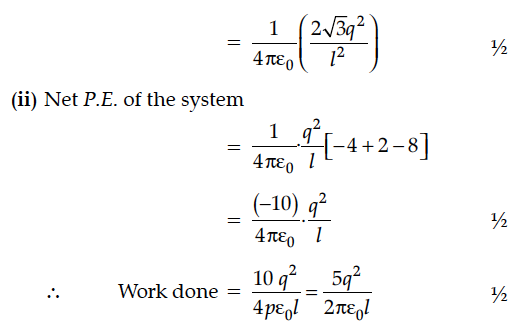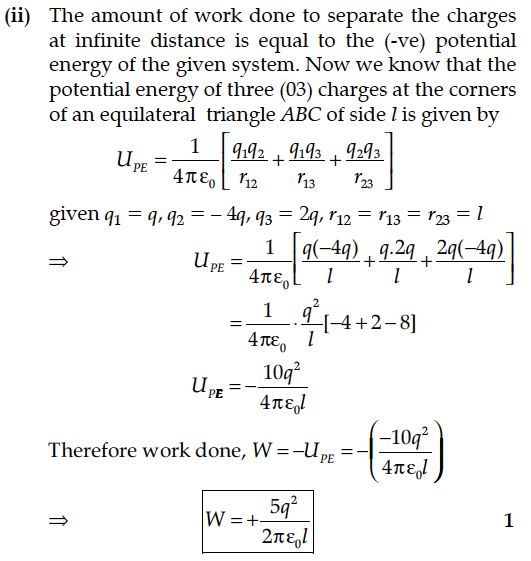(i) Three point charges q, – 4q and 2q are placed at the vertices of an equilateral triangle ABC of side ‘l’ as shown in the figure. Obtain the expression for the magnitude of the resultant electric force acting on the charge q.

(ii) Find out the amount of the work done to separate the charges at infinite distance.

(ii) Find out the amount of the work done to separate the charges at infinite distance.



Four point charges Q, q, Q and q are placed at the corners of a square of side ‘a’ as shown in the figure.
Two point charges q1 and q2 are located at and respectively in an external electric field E. Obtain the expression for the total work done in assembling this configuration.
Two point charges q and –2q are kept d distance apart. Find the location of the point relative to charge q at which potential due to this system of charges is zero.
Four point charges –Q,-q,2q,2Q are placed at different corners of a square . The relation between Q and q for which the potential at the center of the square is zero
1.Q=q
2.Q=1/q
3.Q=-q
4. Q=-1/q
A charge Q is placed at the origin. The electric potential due to this charge at a given point in space is V. The work done by an external force in bringing another charge q from infinity up to the point is
(a) v/q
(b) vq
(c) v+q
(d) v
A charge ‘q’ is moved from a point A above a dipole of dipole moment ‘p’ to a point B below the dipole in equatorial plane without acceleration. Find the work done in the process.
A test charge q is moved without acceleration from A to C along the path from A to B and then from B to C in electric field E as shown in the figure.
A particle, having a charge +5 µC, is initially at rest at the point x = 30 cm on the x-axis. The particle begins to move due to the presence of a charge Q that is kept fixed at the origin. Find the kinetic energy of the particle at the instant it has moved 15 cm from its initial position if
(a) Q = +15 µC and
(b) Q = – 15 µC
An inductor L of inductance is connected in series with a bulb B and an ac source. How would brightness of the bulb change when
(i) number of turns in the inductor is reduced,
(ii) an iron rod is inserted in the inductor and
(iii) a capacitor of reactance is inserted in series in the circuit. Justify your answer in each case.
A sinusoidal voltage of peak value 10 V is applied to a series LCR circuit in which resistance,capacitance and inductance have values of 10 Ω,1 µF and 1 H respectively. Find
(i) the peak voltage across the inductor at resonance
(ii) quality factor of the circuit.
(i) Write two properties by which electric potential is related to the electric field.
(ii) Two point charges q₁ and q₂ separated by a distance of r₁₂ are kept in an external electric field. Derive an expression for the potential energy of the system of two charges in the field.
(i) Derive the expression for the electric potential due to an electric dipole at a point on its axial line.
(ii) Depict the equipotential surface due to electric dipole.
The current, in the LCR circuit shown in the figure is observed to lead the voltage in phase. Without making any other change in the circuit, a capacitor,of capacitance C₀, is (appropriately) joined to the capacitor C. This results in making the current,in the ‘modified’ circuit, flow in phase with theapplied voltage.
Draw a diagram of the ‘modified’ circuit and obtain an expression for C₀ in terms of ω, L and C.
Obtain the expression for the energy density of magnitude field B produced in the inductor.
